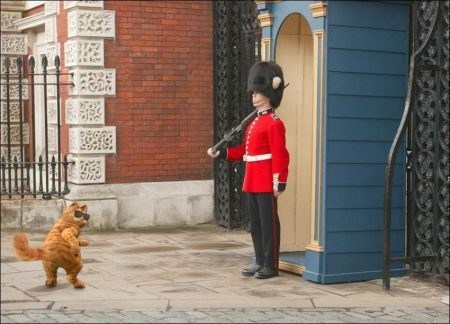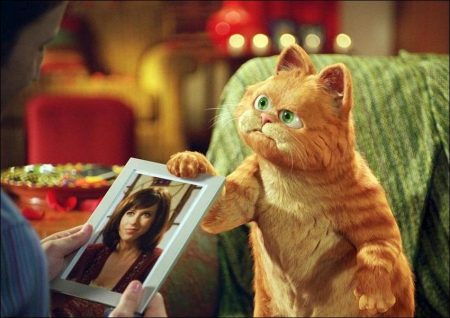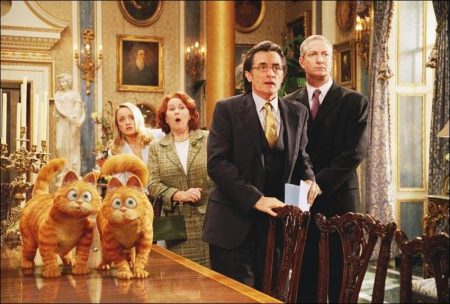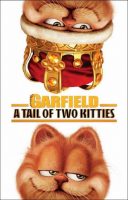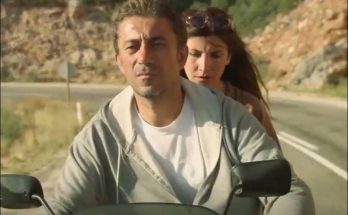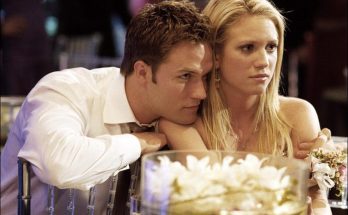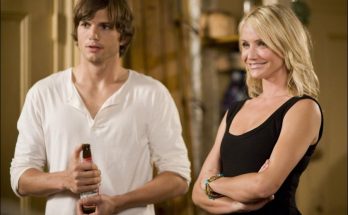America’s favorite feline, Garfield, follows his owner, Jon, to England. The U.K. may never recover, as Garfield is mistaken for a look-alike, regal cat who has inherited a castle. Garfield savors the royal treatment afforded by his loyal “subjects,” but his “reign” is in jeopardy. The nefarious Lord Dargis is determined to do away with Garfield, so he can turn the castle into a resort.
Garfield, the world’s favorite cat, has begun his very own British Invasion, wreaking havoc on the entire United Kingdom. He’s traveled across the pond (with canine sidekick Odie) to surprise his master, Jon Arbuckle (Breckin Meyer), who is in London to propose to his girlfriend, Liz Wilson (Jennifer Love Hewitt).
Garfield came… he saw… he conquered: Big Ben, Buckingham Palace, Scotland Yard and his new favorite dish: minced pie (okay, it’s not lasagna, but you can’t have everything). As befitting an adventure worthy of a feline phenomenon, Garfield has switched places with Prince, a royal cat who has just inherited a castle. Now the castle is Garfield’s — and who’s more deserving?
In the grand estate Garfield now calls home, he’s receiving the royal treatment, including a butler and an international array of four-legged servants and followers. It’s a life fit for a king…even though Garfield is only a prince; in fact, he’s the real “Prince and the Paw-purr.”
Uneasy is the head, however, that wears the crown. Lord Dargis, who is next in line to inherit the estate, wants Prince/Garfield out of the picture. And Garfield finds his bigger, better, more purr-fect world turned upside down in this tale of two kitties.
In the grand estate Garfield now calls home, he’s receiving the royal treatment, including a butler and an international array of four-legged servants and followers. It’s a life fit for a king…even though Garfield is only a prince; in fact, he’s the real “Prince and the Paw-purr.”
In 2004, Garfield, the world’s most popular comic strip character, became a major motion picture star. His eponymous live action/computer-generated film debut, adapted from the syndicated cartoon strip read in 2,600 newspapers by 260 million readers around the globe, became a global blockbuster theatrically and on DVD. Garfield finally had an epic story that was as large as his ego — one that could barely be contained by the big screen.
Producer John Davis, whose many hits include “Doctor Dolittle” and “Daddy Day Care,” was a natural to bring “Garfield” and the all-new follow-up feature Garfield: A Tail of Two Kitties to life on the big screen. “It was about time that Garfield becomes a big movie star,” says Davis. “He’s lazy, funny, crotchety and he has attitude. It doesn’t matter if you’re five years old or fifty; everyone can relate to him on some level.”
Davis is a true Garfield fan. “I loved the comic strip as a kid, and I am truly honored that [Garfield creator] Jim Davis granted me the opportunity to take that franchise and turn it into movies. I think Jim has created an icon that spans the world.”
Jim Davis (no relation to John) was, of course, delighted to see his creation become an international film sensation. “I think Garfield is popular to people of all ages for several reasons,” says Davis. “He’s a very physical animal when it comes to humor, and kids love that. Teens identify with his resentment for authority; he’s very much his own cat. And on an adult level, he relieves our guilt about such little foibles as over-eating, sleeping too much, not exercising enough, or being unmotivated. He has the courage to say and do a lot of things that we wouldn’t. So he speaks for a lot of us.”
For Garfield’s second film, John Davis wanted a bigger canvass and grander concept worthy of Garfield’s worldwide big-screen stardom. “We wanted to take Garfield out of his usual environs — owner Jon Arbuckle’s home on a cul-de-sac,” says Davis, “and take him to a more exotic location.”
Davis again turned to Joel Cohen and Alec Sokolow, the screenwriting duo behind “Garfield,” as well as the live-action comedy hits “Just Married” and “Cheaper by the Dozen,” to write Garfield’s second movie adventure.
Sokolow’s neighbors provided the inspiration for his and Cohen’s screenplay for Garfield: A Tail of Two Kitties. “A married couple who lived near me had passed away, and their will stipulated that their maid could live in their home — provided the maid took care of the couple’s dog,” Sokolow explains.
From that idea, Sokolow and Cohen brainstormed several other concepts they incorporated into their screenplay. “For the new film, we wanted Garfield to be a reactive comic character, and we needed to place him somewhere interesting where he could react — and make him a fish out of water,” Sokolow continues. Enter Merry Ole England… and a royal makeover for the famed feline. “There’s a sense of pomp and circumstance in England that we thought we could have a lot of fun with,” says Joel Cohen. “A royal lifestyle sometimes carries a ridiculous protocol, which seemed ripe for the `Garfield treatment’.”
Next came the notion of a Garfield doppelganger who, while being Garfield’s physical double, has a completely different personality. Working with John Davis and the studio, the writers combined these ideas; then, says Sokolow, “a light bulb went on about incorporating a prince-and-the-pauper element into the story.”
As they had done on the first “Garfield,” the writers consulted Jim Davis about the story. “Jim understands who Garfield is better than anyone else,” says Cohen. “Garfield’s voice and world view is very important to Jim, and was a strong influence as we wrote the script.”
“So when we’d pitch ideas to Jim, if he didn’t like something, he’d say `Well that’s nice,’ unenthusiastically,” says Sokolow. “When he really liked something, he’d say, `Well that’s NICE.’ They would be the same words, but a totally different inflection. So he steered us in his own subtle way.”
Director Tim Hill, who wrote “The SpongeBob SquarePants Movie” and directed “Muppets from Space” and “Max Keeble’s Big Move,” was intrigued by Cohen and Sokolow’s premise, leading the filmmaker to do further research on the subject of people leaving property to their pets. “I went online and discovered many instances of owners providing a sizeable inheritance to their pets,” says Hill. “I really liked that as a starting point for our tale.”
Hill also appreciated the story’s British setting. “In England, Garfield’s not only a fish out water, he’s a bull in a china shop,” says the director.
Hill and John Davis were intent on bringing back the starring cast from the original film: Breckin Meyer as Garfield’s much put-upon owner, Jon Arbuckle, Jennifer Love Hewitt as veterinarian Liz Wilson, the object of Jon’s affection; and, as the voice of Garfield himself, legendary actor Bill Murray.
John Davis recalls that casting Garfield’s voice was one of the major challenges the filmmakers faced in the debut feature. “We looked for someone with a biting, satirical, iconic and brilliant sense of comedy, and we were fortunate to get the perfect actor: Bill Murray.”
Jim Davis adds, “Bill Murray is hilarious. He has just the right delivery and attitude to be the cat. It was perfect casting.
“In both films, Bill provided the perfect synergy and attitude to the character,” Jim Davis continues. “Half the work was done when Bill agreed to do the voice because everybody knows Bill for that attitude. Everyone knows Garfield for his attitude. So when you have Bill’s voice, you’re halfway home.
For the first “Garfield,” the work of the animators who brought Garfield to life, inspired Murray’s voice performance. For Garfield: A Tail of Two Kitties, Murray recorded his part in a more traditional manner, prior to production, and his voice set the timing of the animators’ performance. “The animators listened carefully to Bill’s voice performance,” says animation supervisor Chris Bailey, “but not to figure out dialogue nuances; instead, they were interested in the bigger picture, i.e. what makes him Bill Murray.
“For this film, we had worked out the growing pains we came across in the original,” adds Bailey, who was animation supervisor on “Garfield” and whose credits also include “X2” and “Fat Albert.”
Another returning actor, Breckin Meyer, describes his on-screen incarnation, Jon Arbuckle, as “a sweet, albeit bumbling, adorable guy. Jon is a good yin to Garfield’s yang.” Meyer particularly appreciated the new film’s heightened romantic stakes: Jon is determined to propose to Liz, even if it means crossing the ocean to do so. “Jon finally deciding to pop the question is a big step for him,” Meyer adds. “It’s one of a few ways he becomes more courageous in this film.”
Meyer again appreciated the fact that the film’s title character was computer generated. “I still have that small `issue’ of being allergic to cats,” Meyer says, “so I was more than happy to work opposite a beanbag,” which stood in for Garfield during principal photography.
Thanks to the decidedly low-tech stand-in, Meyer says interacting with Garfield was much easier in the new film. “In `Garfield,’ I had to pantomime my scenes with a then non-existent Garfield,” he recalls. “In this one, the black beanbag enabled me to feel the character’s weight.
“Also, at the beginning of this production, [animation supervisor] Chris Bailey explained to me that the more interaction I do with Garfield — petting him, scratching his ears — the more believable Garfield becomes. So that gave me the freedom to know that I can do no wrong. If I decided to pet him in a certain place, they’ll move Garfield to that place. I can do whatever I want with him, and the animators will love it or fix it,” says Meyer.
Like Meyer, Jennifer Love Hewitt was delighted to reprise her “Garfield” role. “I grew up watching the Garfield cartoon series, and even got a big orange cat,” she says. “I tried Garfield’s favorite dish, lasagna, for the first time when I was making the movie. But what I now love most about Garfield is his sarcasm. I’m very sarcastic too, so I appreciate that kind of humor.”
In Garfield: A Tail of Two Kitties, Hewitt experiences an on-screen “first.” “I’ve never been proposed to before,” admits the actress. “That element of the story was a lot of fun.” What wasn’t new for Hewitt was working with an invisible co-star. “In the first `Garfield,’ working with a co-star who wasn’t ever there, was a little daunting,” she admits. “But, now, after that film and my television series `The Ghost Whisperer,’ where I communicate with ghosts, I’m really talking to myself a lot these days.” Juggling schedules on Garfield: A Tail of Two Kitties and “The Ghost Whisperer” was challenging for the actress. Hewitt worked on the series Monday through Friday night; on Sundays, she’d report to the film set. “It was a lot to handle,” Hewitt says, “but I loved both projects, so I was very enthusiastic to come to work each day,” she says.
Joining “Garfield” veterans Hewitt, Meyer and Murray is Scottish comedian and actor Billy Connolly, as the villainous Lord Dargis. Connolly describes Dargis as a “nasty, lazy piece of work. And he crashes around thinking he’s clever, but he’s really a shifty, upper class twit.
Garfield: A Tail of Two Kitties showcases Connolly’s physical comedy skills. “I get hit on the head with a rake, chased over a fence and bitten by a Rottweiler, fall down a flight of stairs, a piano cover falls on my hands, and I duel with Breckin Meyer,” says Connolly. “Everyone’s out to get me in this film. It’s real slapstick comedy, and was a good excuse for me to just run around being silly.”
The filmmakers, including Tim Hill, appreciated Connolly’s humor and acting talent. “Billy was very authentic in his portrayal of Lord Dargis,” says Hill. “He knows some of the aristocracy there, so he modeled his character after some Lords he’s come across over the years. His Dargis is always pompous — and used to getting his way.”
The filmmakers assembled an impressive cast for the voices of the animals in Garfield: A Tail of Two Kitties. Joining Bill Murray as Garfield are Tim Curry as the upper crust voice of Prince; acclaimed English actor Bob Hoskins (“Mrs. Henderson Presents”) as the voice of Winston, a bulldog; Rhys Ifans (“Notting Hill”) as the voice of Scottish hare McBunny; “Frasier’s” Jane Leeves as the voice of a duck, Eenie, “X-Men: The Last Stand’s” Vinnie Jones as the voice of an attack dog named Rommel; Jane Horrocks as another duck, Meenie; and Sharon Osbourne of MTV’s “The Osbournes” fame, as the voice of Christophe, a goose.
A Tail of Two (CG) Garfields
Animation supervisor Chris Bailey and the visual effects team at Rhythm & Hues Studios (which worked on “Garfield,” “Dr. Dolittle” and “Dr. Dolittle 2”), together created the on-screen Garfield, infusing him with his trademark cartoon characteristics: girth, hooded eyes and toothy grin.
To create the CG Garfield, the filmmakers first rehearsed with a maquette (a stuffed Garfield stand-in) so the camera operator could note Garfield’s location in a scene at a given time, and the actors could have something to react to.
After these rehearsals, scenes were shot without a maquette or any “stand-in,” to give the visual effects artists a space to place the CG Garfield. In part three of this process, a neutral grey sphere, and then a shiny mirrored sphere, were photographed exactly in the spot where Garfield ultimately would appear. This gave the animators a sense of the direction and quantity of lights hitting him, and accurately showed reflections of light off his flesh or his eyes.
Rhythm & Hues created a “biological” Garfield, comprised of bones, muscles and eye color, to serve as a template for the final, animated character. The visual effects artists scanned that material into a computer, and began building the CG characters from the set information. Then, they recreated the camera moves and lighting that were used on set, ultimately merging them with the animation.
Bailey worked with a team of 30 animators to bring to life Garfield and Prince. Thanks to technical advances developed at Rhythm & Hues, the effects artists and animators made small but important “upgrades” to Garfield. Bailey says audiences will, at least subliminally, feel the improvements.
“In addition to more realistic hair, Garfield has a more natural looking anatomy from his shoulders to his toes,” Bailey explains. “Garfield is more anthropomorphic in this movie because he spends more time walking on his hind legs and using his front paws, like hands; in the first film he walked on all fours, like a real cat. We’ve adjusted his body so that he’ll look more appealing when he walks upright.”
The two cats are almost physically identical, but have distinct voices, personalities, smiles, attitudes and mannerisms. “Prince walks more gracefully than Garfield, and Prince holds his nose in the air in true upper-crust fashion,” says Bailey. “They have different mannerisms, and of course, a different voice, since Prince is played by Tim Curry. Garfield is a bit clumsier, and will seem heavier when he is in motion. Prince moves like a snooty cat, and Garfield moves more like a clunky dog.”
The Animals Speak
As Bailey, the animators, and Rhythm & Hues worked to create a new and improved Garfield, Vancouver- based visual effects house Rainmaker Animation and Visual Effects gave the film’s real-life animals the power of speech — a painstaking process taking six months, in which 200 animators mapped-out, via computer, much of the animals’ faces.
It was imperative to have the CG and live-action animal voices recorded before computer generation work began. Says Rhythm & Hues visual effects supervisor Betsy Paterson: “Because the animation is so frame specific to an actor’s precise voice and inflections, we videotaped the actors so we could incorporate some of their mannerisms and facial expressions into the actor’s animal character.”
The one real animal who doesn’t speak is Jon’s beloved pooch — and the bane of Garfield’s existence — Odie. Two adorable half dachshund and half cairn terriers, Tyler and sister and Chloe, reprise their “Garfield” role as Odie. It took the dogs’ trainer, Kristy Campbell, about four weeks, before production began, to teach them their new behaviors for the part.
Even though the dogs look alike, they have very different personalities, and they were called upon for different scenes. Tyler acted in the cute, sensitive or difficult scenes. “He’s very intelligent, and takes direction very well; he’s easy to train. Chloe is great for the really crazy stuff, like attacking a pant leg, because she’s fearless,” says Campbell.
The film’s menagerie was supplied by Birds and Animals Unlimited, and overseen by animal coordinator Mark Forbes. One of Forbes’ biggest challenges was to find a bull to play the character, Bolero. “I wasn’t sure you could actually train a bull, especially to do liberty work, which is working without a halter,” says Forbes. “I thought, you could only push a bull so far, and they’d push back. But we found an incredible liberty livestock trainer, and his bull, Butch, performed beyond my expectations. He’d come in and hit a mark, turn his head on cue, shake his head on cue, and do a bow. I was ecstatic with Butch.”
At times the production must have looked like Noah’s Ark, with animals being herded across vast soundstages and sets. To accommodate the challenges presented by working with so many four-legged “actors,” two units filmed concurrently. The first unit, led by director Tim Hill, shot the human actors, Garfield, Odie and, sometimes, the other prominently-featured animals. The second unit, headed by second unit director / director of photography Dean Cundey, ASC — who was director of photography on “Garfield” — filmed the animals-only scenes.
Sequences in which the CG Garfield interacted with the live-action animals were arduous and time-consuming — and, according to Cundey, sometimes the most fun to capture. For example, one of the film’s set pieces has Garfield getting the castle menagerie to work as a team. Their mission: create from scratch enough lasagna to feed an empire — or at least Garfield’s insatiable taste for the dish. Theirs is a true team effort: a dog carries a bag of flour; a bird pulls the string off the bag; a bunny cranks out pasta from a pasta machine. It’s Garfield’s master class in cooking and teamwork.
“That scene, with so many animals, took an incredible amount of patience,” says Dean Cundey. “The animals performed intricate movements. But it turned out to be a fun musical sequence with each of the animals taking a different part in the process.”
Animal supervisor Mark Forbes studied the scene and talked to the animal trainers to see which creatures were best at specific behaviors. “For instance,” says Forbes, “we learned that our goat would be good at crushing tomatoes in a barrel, so he got that part. We have a bull bringing garlic in and dropping it off his horn. We have a crow picking up a string on a flour sack and flying off with it; this opens the bag.
“We also made props that were very specific to certain animals,” Forbes continues. “There’s a pasta maker that has a little wheel and a flat piece on it so that the rabbit can put his foot on it. Then there’s a motor that’s turning that wheel. So it looks look like the rabbit’s actually rolling the pasta out.”
Adds Tim Hill: “We had to film the scene in several stages. First, we shot the kitchen without any animals in it. Then we had to layer in the animals in three stages. It took 45 different shots to make up the scene, which took four days to film.”
Cundey’s second unit filmed the aftermath of the animal’s ambitious undertaking, where all the animals and Garfield sit and partake of their gastronomic creation.
Principal photography on Garfield: A Tail of Two Kitties commenced in England. The production shot at several London tourist attractions visited by Garfield in the story, including Buckingham Palace, Westminster Abby, Trafalgar Square, Big Ben, and the Winston Churchill statue.
The production traveled to York, England to film exteriors at Castle Howard, a magnificent 18th century estate that stood in for Prince’s home, “Carlyle Castle.” Surrounded by 10,000 acres of breathtaking parkland and gardens, Castle Howard is one of England’s most beautiful historic houses, and has been home to the Howard family since it was built.
The Los Angelels-based production returned to Southern California to film at stately Greystone Mansion in Beverly Hills, which doubled for Castle Carlyle interiors and some of its gardens. Production designer Tony Burrough chose Greystone because, as he points out, it is an “amalgamation of many English country homes.”
Los Angeles area soundstages doubled for Castle Carlyle’s ballroom and kitchen, the latter based on the famous English estate, Burghley House in Cambridgeshire. Burrough created an authentic English stately home within the confines of Greystone and the studio soundstages. “But I did bear in mind,” he notes, “that this home is in a `Garfield’ movie, not a Jane Austen film. Therefore everything is a little bit brighter, lighter and more colorful than you might normally see in England.”
Garfield’s second big-screen incarnation takes the feline phenom to another level in scale, adventure and fun. But, as Jim Davis points out, the films also bring new dimensions to his decades-old creation. “In `Garfield,’ Garfield learned to accept Odie and have some heroic moments. In Garfield: A Tail of Two Kitties, he’s living the good life in an English castle and getting pretty full of himself. Then he gets knocked down a few notches — and gets some humility. In the end, he doesn’t save the day by himself; he learns the value of teamwork, and works together with his `subjects’ to save the day.”
But can you really teach an old cat, new tricks? One thing is for certain: Wherever Garfield finds himself — be it at his longtime home at a suburban American cul-de-sac, or in a grand English castle — he will always be the master of his “kingdom.”
Garfield: A Tail of Two Kitties (2006)
Directed by: Tim Hill
Starring: Breckin Meyer, Jennifer Love Hewitt, Billy Connolly, Bill Murray, Ian Abercrombie, Roger Rees, Lucy Davis, Lena Cardwell, Veronica Alicino, Jane Carr, Oliver Muirhead
Screenplay by: Joel Cohen & Alec Sokolow and Tim Hill
Production Design by: Tony Burrough
Cinematography by: Peter Lyons Collister
Film Editing by: Peter S. Elliot
Costume Design by: Francine Jamison-Tanchuck
Set Decoration by: Anne D. McCulley
Art Direction by: Louis M. Mann, Brian Ollman
Music by: Christophe Beck
MPAA Rating: PG for some off-color elements.
Distributed by: 20th Century Fox
Release Date: June 23, 2006
Visits: 55
